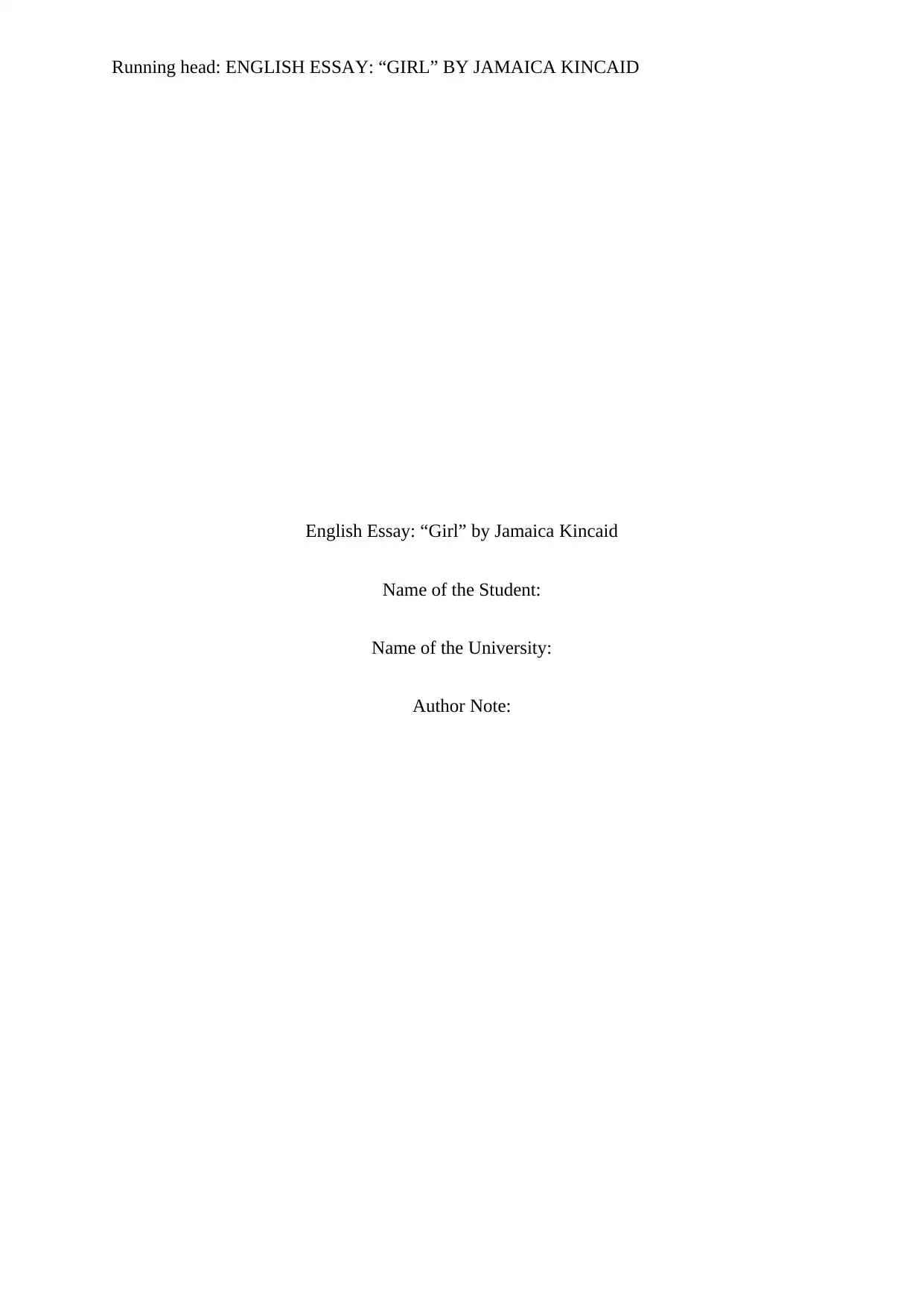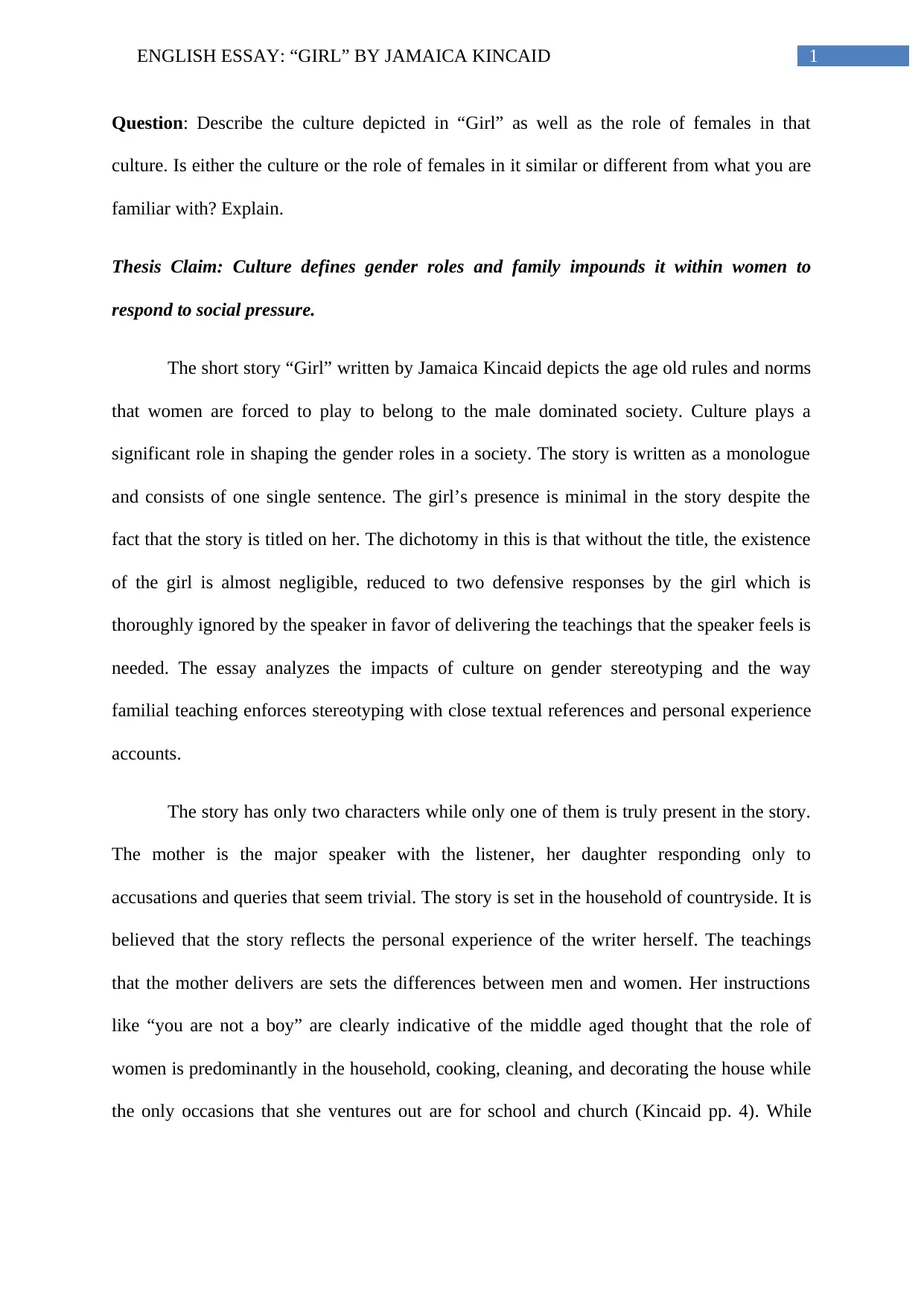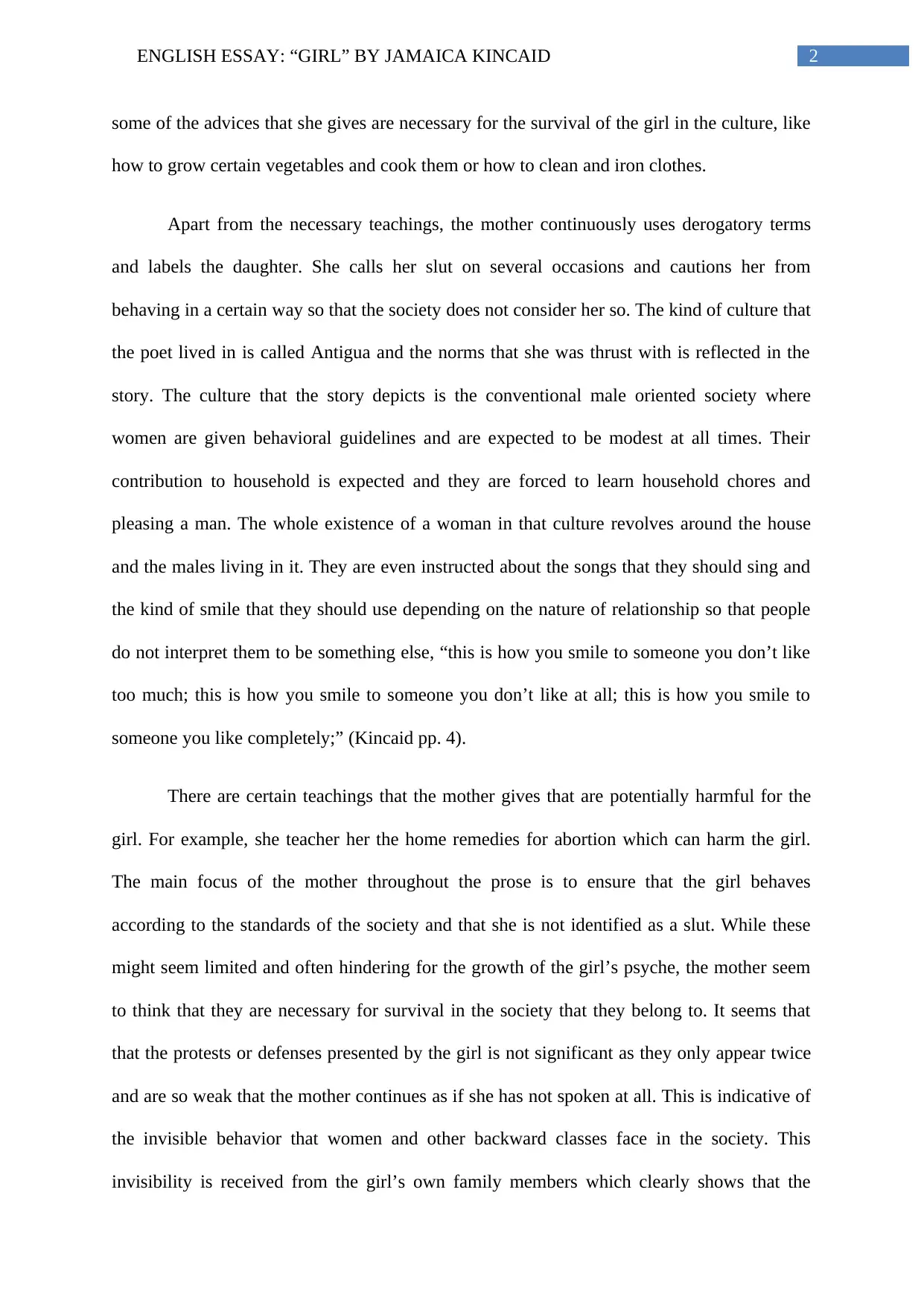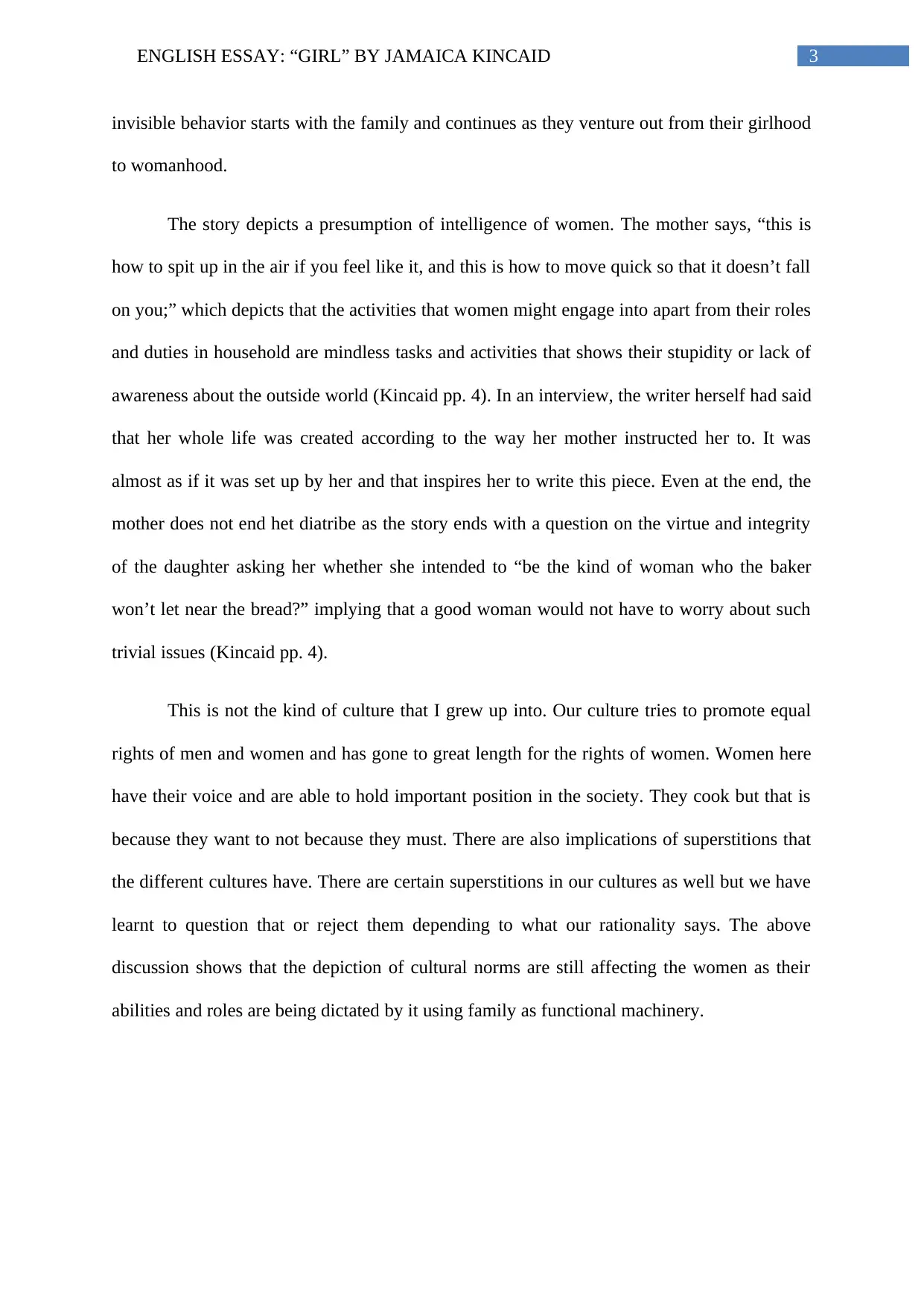Essay: Culture, Gender, and Family in Jamaica Kincaid's 'Girl'
VerifiedAdded on 2022/08/24
|5
|1210
|22
Essay
AI Summary
This essay analyzes Jamaica Kincaid's short story "Girl," focusing on the depiction of culture and gender roles within the narrative. The essay argues that culture defines gender roles, and family reinforces these roles, compelling women to conform to societal pressures. Through a close reading of the text, the essay examines how the mother's instructions to her daughter reflect the norms of Antiguan society, where women are expected to adhere to specific behavioral guidelines and prioritize household duties. The analysis highlights the impact of cultural stereotyping and familial teachings on the girl's development, contrasting the depicted culture with the author's personal experiences. The essay also explores the potential harm of some of the mother's instructions, emphasizing the pressure on the girl to conform and avoid being labeled by society. The essay concludes by reflecting on the cultural differences and the ongoing influence of cultural norms on women's roles, using family as a functional machinery.

Running head: ENGLISH ESSAY: “GIRL” BY JAMAICA KINCAID
English Essay: “Girl” by Jamaica Kincaid
Name of the Student:
Name of the University:
Author Note:
English Essay: “Girl” by Jamaica Kincaid
Name of the Student:
Name of the University:
Author Note:
Paraphrase This Document
Need a fresh take? Get an instant paraphrase of this document with our AI Paraphraser

1ENGLISH ESSAY: “GIRL” BY JAMAICA KINCAID
Question: Describe the culture depicted in “Girl” as well as the role of females in that
culture. Is either the culture or the role of females in it similar or different from what you are
familiar with? Explain.
Thesis Claim: Culture defines gender roles and family impounds it within women to
respond to social pressure.
The short story “Girl” written by Jamaica Kincaid depicts the age old rules and norms
that women are forced to play to belong to the male dominated society. Culture plays a
significant role in shaping the gender roles in a society. The story is written as a monologue
and consists of one single sentence. The girl’s presence is minimal in the story despite the
fact that the story is titled on her. The dichotomy in this is that without the title, the existence
of the girl is almost negligible, reduced to two defensive responses by the girl which is
thoroughly ignored by the speaker in favor of delivering the teachings that the speaker feels is
needed. The essay analyzes the impacts of culture on gender stereotyping and the way
familial teaching enforces stereotyping with close textual references and personal experience
accounts.
The story has only two characters while only one of them is truly present in the story.
The mother is the major speaker with the listener, her daughter responding only to
accusations and queries that seem trivial. The story is set in the household of countryside. It is
believed that the story reflects the personal experience of the writer herself. The teachings
that the mother delivers are sets the differences between men and women. Her instructions
like “you are not a boy” are clearly indicative of the middle aged thought that the role of
women is predominantly in the household, cooking, cleaning, and decorating the house while
the only occasions that she ventures out are for school and church (Kincaid pp. 4). While
Question: Describe the culture depicted in “Girl” as well as the role of females in that
culture. Is either the culture or the role of females in it similar or different from what you are
familiar with? Explain.
Thesis Claim: Culture defines gender roles and family impounds it within women to
respond to social pressure.
The short story “Girl” written by Jamaica Kincaid depicts the age old rules and norms
that women are forced to play to belong to the male dominated society. Culture plays a
significant role in shaping the gender roles in a society. The story is written as a monologue
and consists of one single sentence. The girl’s presence is minimal in the story despite the
fact that the story is titled on her. The dichotomy in this is that without the title, the existence
of the girl is almost negligible, reduced to two defensive responses by the girl which is
thoroughly ignored by the speaker in favor of delivering the teachings that the speaker feels is
needed. The essay analyzes the impacts of culture on gender stereotyping and the way
familial teaching enforces stereotyping with close textual references and personal experience
accounts.
The story has only two characters while only one of them is truly present in the story.
The mother is the major speaker with the listener, her daughter responding only to
accusations and queries that seem trivial. The story is set in the household of countryside. It is
believed that the story reflects the personal experience of the writer herself. The teachings
that the mother delivers are sets the differences between men and women. Her instructions
like “you are not a boy” are clearly indicative of the middle aged thought that the role of
women is predominantly in the household, cooking, cleaning, and decorating the house while
the only occasions that she ventures out are for school and church (Kincaid pp. 4). While

2ENGLISH ESSAY: “GIRL” BY JAMAICA KINCAID
some of the advices that she gives are necessary for the survival of the girl in the culture, like
how to grow certain vegetables and cook them or how to clean and iron clothes.
Apart from the necessary teachings, the mother continuously uses derogatory terms
and labels the daughter. She calls her slut on several occasions and cautions her from
behaving in a certain way so that the society does not consider her so. The kind of culture that
the poet lived in is called Antigua and the norms that she was thrust with is reflected in the
story. The culture that the story depicts is the conventional male oriented society where
women are given behavioral guidelines and are expected to be modest at all times. Their
contribution to household is expected and they are forced to learn household chores and
pleasing a man. The whole existence of a woman in that culture revolves around the house
and the males living in it. They are even instructed about the songs that they should sing and
the kind of smile that they should use depending on the nature of relationship so that people
do not interpret them to be something else, “this is how you smile to someone you don’t like
too much; this is how you smile to someone you don’t like at all; this is how you smile to
someone you like completely;” (Kincaid pp. 4).
There are certain teachings that the mother gives that are potentially harmful for the
girl. For example, she teacher her the home remedies for abortion which can harm the girl.
The main focus of the mother throughout the prose is to ensure that the girl behaves
according to the standards of the society and that she is not identified as a slut. While these
might seem limited and often hindering for the growth of the girl’s psyche, the mother seem
to think that they are necessary for survival in the society that they belong to. It seems that
that the protests or defenses presented by the girl is not significant as they only appear twice
and are so weak that the mother continues as if she has not spoken at all. This is indicative of
the invisible behavior that women and other backward classes face in the society. This
invisibility is received from the girl’s own family members which clearly shows that the
some of the advices that she gives are necessary for the survival of the girl in the culture, like
how to grow certain vegetables and cook them or how to clean and iron clothes.
Apart from the necessary teachings, the mother continuously uses derogatory terms
and labels the daughter. She calls her slut on several occasions and cautions her from
behaving in a certain way so that the society does not consider her so. The kind of culture that
the poet lived in is called Antigua and the norms that she was thrust with is reflected in the
story. The culture that the story depicts is the conventional male oriented society where
women are given behavioral guidelines and are expected to be modest at all times. Their
contribution to household is expected and they are forced to learn household chores and
pleasing a man. The whole existence of a woman in that culture revolves around the house
and the males living in it. They are even instructed about the songs that they should sing and
the kind of smile that they should use depending on the nature of relationship so that people
do not interpret them to be something else, “this is how you smile to someone you don’t like
too much; this is how you smile to someone you don’t like at all; this is how you smile to
someone you like completely;” (Kincaid pp. 4).
There are certain teachings that the mother gives that are potentially harmful for the
girl. For example, she teacher her the home remedies for abortion which can harm the girl.
The main focus of the mother throughout the prose is to ensure that the girl behaves
according to the standards of the society and that she is not identified as a slut. While these
might seem limited and often hindering for the growth of the girl’s psyche, the mother seem
to think that they are necessary for survival in the society that they belong to. It seems that
that the protests or defenses presented by the girl is not significant as they only appear twice
and are so weak that the mother continues as if she has not spoken at all. This is indicative of
the invisible behavior that women and other backward classes face in the society. This
invisibility is received from the girl’s own family members which clearly shows that the
⊘ This is a preview!⊘
Do you want full access?
Subscribe today to unlock all pages.

Trusted by 1+ million students worldwide

3ENGLISH ESSAY: “GIRL” BY JAMAICA KINCAID
invisible behavior starts with the family and continues as they venture out from their girlhood
to womanhood.
The story depicts a presumption of intelligence of women. The mother says, “this is
how to spit up in the air if you feel like it, and this is how to move quick so that it doesn’t fall
on you;” which depicts that the activities that women might engage into apart from their roles
and duties in household are mindless tasks and activities that shows their stupidity or lack of
awareness about the outside world (Kincaid pp. 4). In an interview, the writer herself had said
that her whole life was created according to the way her mother instructed her to. It was
almost as if it was set up by her and that inspires her to write this piece. Even at the end, the
mother does not end het diatribe as the story ends with a question on the virtue and integrity
of the daughter asking her whether she intended to “be the kind of woman who the baker
won’t let near the bread?” implying that a good woman would not have to worry about such
trivial issues (Kincaid pp. 4).
This is not the kind of culture that I grew up into. Our culture tries to promote equal
rights of men and women and has gone to great length for the rights of women. Women here
have their voice and are able to hold important position in the society. They cook but that is
because they want to not because they must. There are also implications of superstitions that
the different cultures have. There are certain superstitions in our cultures as well but we have
learnt to question that or reject them depending to what our rationality says. The above
discussion shows that the depiction of cultural norms are still affecting the women as their
abilities and roles are being dictated by it using family as functional machinery.
invisible behavior starts with the family and continues as they venture out from their girlhood
to womanhood.
The story depicts a presumption of intelligence of women. The mother says, “this is
how to spit up in the air if you feel like it, and this is how to move quick so that it doesn’t fall
on you;” which depicts that the activities that women might engage into apart from their roles
and duties in household are mindless tasks and activities that shows their stupidity or lack of
awareness about the outside world (Kincaid pp. 4). In an interview, the writer herself had said
that her whole life was created according to the way her mother instructed her to. It was
almost as if it was set up by her and that inspires her to write this piece. Even at the end, the
mother does not end het diatribe as the story ends with a question on the virtue and integrity
of the daughter asking her whether she intended to “be the kind of woman who the baker
won’t let near the bread?” implying that a good woman would not have to worry about such
trivial issues (Kincaid pp. 4).
This is not the kind of culture that I grew up into. Our culture tries to promote equal
rights of men and women and has gone to great length for the rights of women. Women here
have their voice and are able to hold important position in the society. They cook but that is
because they want to not because they must. There are also implications of superstitions that
the different cultures have. There are certain superstitions in our cultures as well but we have
learnt to question that or reject them depending to what our rationality says. The above
discussion shows that the depiction of cultural norms are still affecting the women as their
abilities and roles are being dictated by it using family as functional machinery.
Paraphrase This Document
Need a fresh take? Get an instant paraphrase of this document with our AI Paraphraser

4ENGLISH ESSAY: “GIRL” BY JAMAICA KINCAID
References
Kincaid, Jamaica. Girl. San Francisco Examiner, 1991. 4.
References
Kincaid, Jamaica. Girl. San Francisco Examiner, 1991. 4.
1 out of 5
Related Documents
Your All-in-One AI-Powered Toolkit for Academic Success.
+13062052269
info@desklib.com
Available 24*7 on WhatsApp / Email
![[object Object]](/_next/static/media/star-bottom.7253800d.svg)
Unlock your academic potential
Copyright © 2020–2025 A2Z Services. All Rights Reserved. Developed and managed by ZUCOL.




